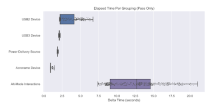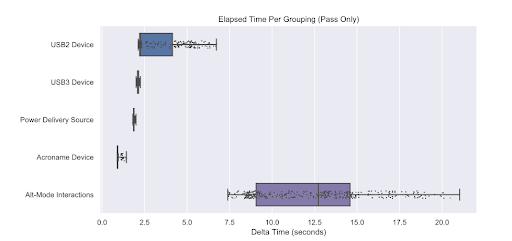
Faster Testing. Fewer Errors. No Cable Flipping Required.
USB-C is everywhere — powering laptops, phones, tablets, monitors, and more. It’s flexible and powerful, but with that comes complexity. If you’re managing production for USB-C devices, the challenge isn’t the port itself. It’s the testing.
One missed defect can lead to a return, a delay, or damage to your brand. And catching that defect after the product ships? That’s costly.
The real issue isn’t USB-C. It’s the outdated, manual testing methods most teams are still using.
The Real Cost of USB-C Testing
Each USB-C port is expected to handle a lot:
- Transfer data at speeds up to 10 Gbps
- Deliver power up to 100W in either direction
- Output video using DisplayPort Alt Mode
- Work in either orientation without issue
- Switch roles between host and device
- Support legacy accessories and alternate modes
- Pass certification and avoid EMI/EMC issues
Now think about how that’s being tested on your line.
Someone plugs in a USB stick and waits. They flip the cable. Try again. Plug in a charger and watch for the battery icon. Maybe they test one or two power profiles — if there’s time.
Best case: about 2 minutes per unit.
Worst case: inconsistent testing, missed edge cases, and expensive surprises down the line.
There’s a Smarter Way to Test USB-C Devices
What if your team could test all those functions in just seconds, and do it more reliably than any manual process?
That’s what Acroname’s USB-C testing tools are designed to do.
These aren’t lab tools adapted for production. They’re industrial-grade systems built specifically for high-throughput lines. They replace slow, manual tasks with fast, automated testing that scales easily across sites.
What Makes Acroname’s USB-C Test Tools a Game-Changer?
- Flip the cable orientation automatically — using Universal Orientation Cables (UOCs). No human error. No missed tests.
- Test every mode — data (up to 10 Gbps), video (4K at 60 Hz), and power delivery (up to 100W) — all in one workflow.
- Catch the subtle defects humans miss — like bad solder joints or signal failures on USB-C's sideband (SBU) lines.
- Cut test times dramatically — from 2 minutes to 14 seconds... or even 4.6 seconds with advanced setup.
- Integrate with your test software — fully controllable, fully scriptable, fully automated.
The Tools Managers Actually Need to Know
We’ll spare you the alphabet soup and keep it simple:
Option 1: USB-C Switch
- Your go-to for fast, automated testing.
- Great for video (DP Alt Mode) and basic power/data checks.
- Replaces cable flips, slashes test times.
Best For: High-speed video testing and basic power/data checks.
Option 2: USBHub3c
- A tool for comprehensive testing.
- Emulates any power profile — source, sink, fast charge, etc.
- Tests both roles (host + device).
- Skips video but covers all other USB-C functions.
- Tests data throughput at both SuperSpeed 10 Gbps and High-Speed 480 Mbps.
Best For: Deep control over power delivery and data testing.
Option 3: Combine Them
The most complete solution for full coverage:
- The USB-C Switch handles video testing, cable flips, and SBU line monitoring.
- The USBHub3c covers advanced power delivery profiles, role swaps, and comprehensive data tests.
Best For: Companies that want no compromises in their testing process..
Proven Results on the Line
One Acroname customer reduced their test time from two minutes to just 14 seconds using the USB-C Switch. Then, by leveraging USB-C’s sideband signaling (instead of waiting for the OS to respond), they dropped that time to only 4.6 seconds.

Faster tests mean more units out the door, fewer errors, and better margins.
Which Solution is Right for You?
- Want speed and simplicity? Go with the USB-C Switch.
- Need deep control and full power testing? That’s USBHub3c.
- Don’t want to compromise? Combine them and run a test lab on your line.
Whichever path you take, here’s what you get:
✔️ No manual errors
✔️ Consistent test quality
✔️ Full automation
✔️ Seamless scaling across sites
✔️ Reporting, logging, and software control
Final Thought: Stop Testing Like It’s 2015
This isn’t just about USB-C ports — it’s about how you run your line:
- How many units you test.
- How many you ship.
- How much profit you keep.
If your team is still flipping cables and waiting for monitors to blink on... it's time for a better way.
Managers don’t need to understand every detail of USB-C technology — they just need tools that make testing faster, smarter, and more reliable.
It’s time to automate. Contact our team of experts to get personalized advice for your USB Testing Solutions.
Add New Comment